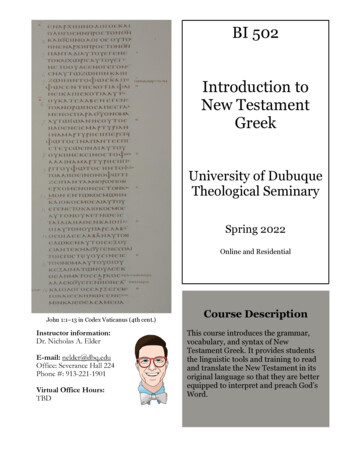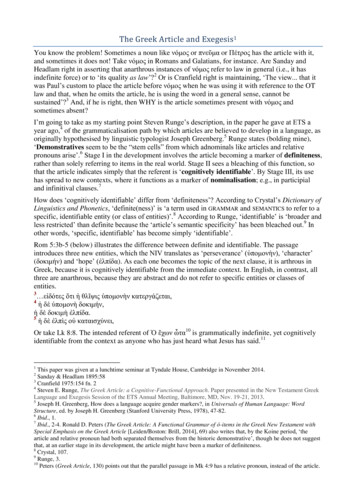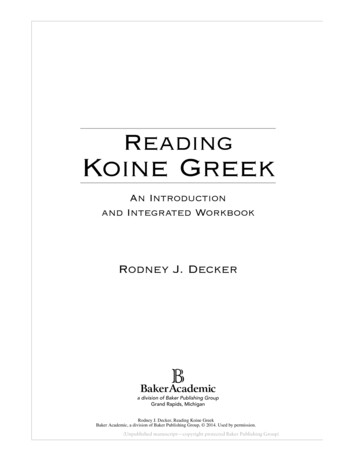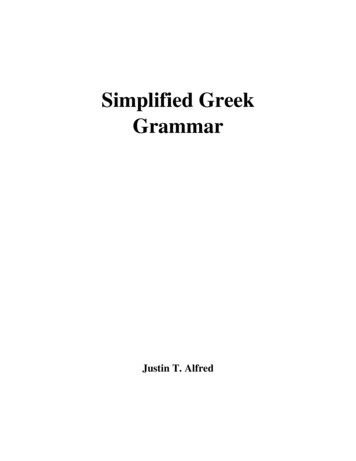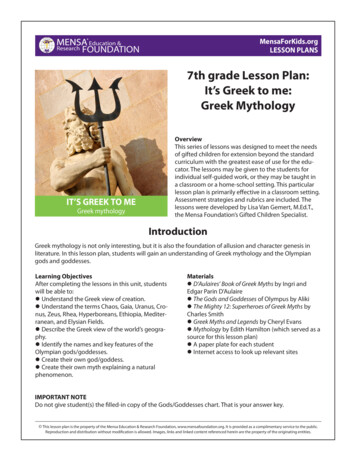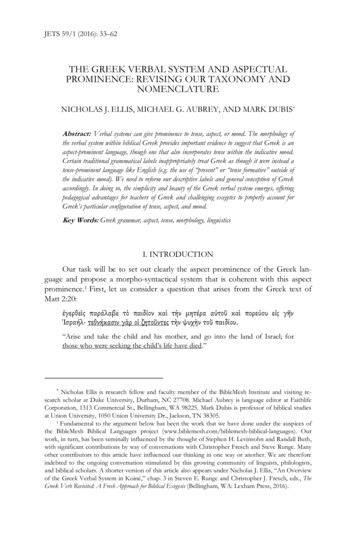
Transcription
JETS 59/1 (2016): 33–62THE GREEK VERBAL SYSTEM AND ASPECTUALPROMINENCE: REVISING OUR TAXONOMY ANDNOMENCLATURENICHOLAS J. ELLIS, MICHAEL G. AUBREY, AND MARK DUBIS*Abstract: Verbal systems can give prominence to tense, aspect, or mood. The morphology ofthe verbal system within biblical Greek provides important evidence to suggest that Greek is anaspect-prominent language, though one that also incorporates tense within the indicative mood.Certain traditional grammatical labels inappropriately treat Greek as though it were instead atense-prominent language like English (e.g. the use of “present” or “tense formative” outside ofthe indicative mood). We need to reform our descriptive labels and general conception of Greekaccordingly. In doing so, the simplicity and beauty of the Greek verbal system emerges, offeringpedagogical advantages for teachers of Greek and challenging exegetes to properly account forGreek’s particular configuration of tense, aspect, and mood.Key Words: Greek grammar, aspect, tense, morphology, linguisticsI. INTRODUCTIONOur task will be to set out clearly the aspect prominence of the Greek language and propose a morpho-syntactical system that is coherent with this aspectprominence.1 First, let us consider a question that arises from the Greek text ofMatt 2:20:ἐγερθεὶς παράλαβε τὸ παιδίον καὶ τὴν μητέρα αὐτοῦ καὶ πορεύου εἰς γῆνἸσραήλ· τεθνήκασιν γὰρ οἱ ζητοῦντες τὴν ψυχὴν τοῦ παιδίου.“Arise and take the child and his mother, and go into the land of Israel; forthose who were seeking the child’s life have died.”* Nicholas Ellis is research fellow and faculty member of the BibleMesh Institute and visiting research scholar at Duke University, Durham, NC 27708. Michael Aubrey is language editor at FaithlifeCorporation, 1313 Commercial St., Bellingham, WA 98225. Mark Dubis is professor of biblical studiesat Union University, 1050 Union University Dr., Jackson, TN 38305.1 Fundamental to the argument below has been the work that we have done under the auspices ofthe BibleMesh Biblical Languages project (www.biblemesh.com/biblemesh-biblical-languages). Ourwork, in turn, has been seminally influenced by the thought of Stephen H. Levinsohn and Randall Buth,with significant contributions by way of conversations with Christopher Fresch and Steve Runge. Manyother contributors to this article have influenced our thinking in one way or another. We are thereforeindebted to the ongoing conversation stimulated by this growing community of linguists, philologists,and biblical scholars. A shorter version of this article also appears under Nicholas J. Ellis, “An Overviewof the Greek Verbal System in Koiné,” chap. 3 in Steven E. Runge and Christopher J. Fresch, eds., TheGreek Verb Revisited: A Fresh Approach for Biblical Exegesis (Bellingham, WA: Lexham Press, 2016).
34JOURNAL OF THE EVANGELICAL THEOLOGICAL SOCIETYIn the phrase τεθνήκασιν γὰρ οἱ ζητοῦντες τὴν ψυχὴν τοῦ παιδίου, we findthe substantival participle οἱ ζητοῦντες. Traditionally, ζητοῦντες would be labeled a“present participle.” But is there anything in the semantics of this term that justifiesthis nomenclature? As we can see quite plainly, there can be no “present time,” forlogically those who “have died” (τεθνήκασιν) cannot now be “searching”(ζητοῦντες) for the child at the time of the speech act. Indeed, the seekers are dead!Moreover, neither can there be “contemporaneous time,” as would typically betaught, given that the searching necessarily occurred prior to dying. Rather, something else seems to be fundamentally in view here, guiding the choice of the verb.In what follows, we will examine how the Greek verbal system matches structurewith function and suggest a nomenclature that matches this structural frameworkbetter than the traditional nomenclature.As any beginning Greek student will know, the standard approach to describing the morphological possibilities of the Greek verb are the six principal parts:present (I), future (II), aorist (III), perfect (IV), perfect middle (V), and aorist passive (VI). The fundamental observation about this system is that it provides a descriptive, organizational, and therefore cognitive framework for the Greek systemthat is based on tense prominence, prioritizing (by its initial position) the presenttense within the indicative mood.In what follows we will argue that this framework is fundamentally flawed. Itfails to reflect the essential organizational principles of the Greek verbal system. Wewill argue that Greek, as an aspect-prominent language, is primarily oriented alonga three-part aspect morphology rather than tense morphology. Recognizing thissimple prototypical structure and reflecting it in our descriptive language has significant implications for both exegesis and pedagogy.II. TENSE, ASPECT, AND MOODAS POTENTIALLY PROMINENT CATEGORIESFirst of all, let us consider what we mean by “grammatical prominence withinthe verb.” Languages tend to emphasize one of three verbal parameters: tense, aspect, or mood. 2 Thus, some languages are grammatically tense-prominent; otherlanguages are grammatically aspect-prominent; and still others are grammaticallymood-prominent.3 In the section that follows, let us examine a brief definition ofthese categories.1. Tense. Tense includes a number of nuanced variables across languages, butgenerally speaking tense provides a temporal frame for an event. Tense is con-2 There are, of course, a number of other grammatical categories related to the verb, including voice,subject agreement, and in some languages, gender, transitivity, causativity, and even object agreement.The typology we present here is oriented around tense, aspect, and mood. Linguists have recognizedthat these three categories are closely related (so much so that they are often simply referred to with theabbreviation TAM).3 This typology is based on D. N. S. Bhat, The Prominence of Tense, Aspect, and Mood (Amsterdam: JohnBenjamins, 1999). Bhat’s work has been found to be an effective typology for a large variety of languages.
THE GREEK VERBAL SYSTEM AND ASPECTUAL PROMINENCE35cerned with a situation’s location in time, usually in terms of being in the past,present, or future. Consider, in English, how tense is portrayed in example 1 below:1a. “Your mother was reading a book.” (past time)1b. “Your mother is reading a book.” (present time)1c. “Your mother will be reading a book.” (future time)In the three sentences of example 1, the speaker adopts the moment ofspeaking as his reference point. Taking that moment as his reference point, we seethree tense choices that the speaker might make as he expresses the relative time ofthe verbal event of the mother reading a book. The speaker’s choice of a tense(past, present, or future) is, indeed, a choice. It should be noted that, while theabove three sentences represent a default description of time, the speaker might forsome practical reason choose to use a different tense and create a mismatch between the historical event and his description of the event. For example, the speaker could have framed a past event with a present tense verb form for heightenedeffect: “so yesterday, your mother is reading a book, and she sees this huge spider .” In this case, the speaker’s reference point is not the speaker’s own time ofspeaking but instead the past time in which the mother has her experience. Eventhough the speaker is describing a past event, the speaker uses present tense verbs.This is an example of what we mean when we say that tense is a “choice.” Although the speaker could have used the past-tense verbs “read” and “saw,” insteadthe speaker uses “is reading” and “sees.” Greek speakers can make similar tensechoices (e.g. the historical present).42. Aspect. If we have a clear mental picture of tense (which, as English speakers, we likely do), then what about aspect?5 Rather than denoting a situation’s location in time, aspect is concerned with an event’s internal temporal structure, or toput it another way, the manner and extent to which time unfolds within a situation.English utilizes two aspects, which can be described as perfective aspect and imperfective (or “progressive”) aspect. Take example 2 below:2a. Jane ate an entire box of chocolates.2b. Jane was eating an entire box of chocolates.If the term aspect was foreign to you before, perhaps you can intuit its meaning from the above example. The clause in example (2a) is in the so-called perfectiveaspect. The perfective aspect presents an event as self-contained. The entire event,with its initiation and conclusion, are presented as a single whole with no reference4 Cf. Steven E. Runge, “The Verbal Aspect of the Historical Present Indicative in Narrative,” inSteven E. Runge, ed., Discourse Studies and Biblical Interpretation: A Festschrift in Honor of Stephen H. Levinsohn(Bellingham, WA: Lexham, 2011), 191–224.5 Broadly speaking, aspect is concerned with a situation’s internal structure, usually in terms of being bounded (self-contained) or unbounded (uncontained). For an excellent recent description of aspect,both of its semantics and its history of scholarship, cf. Chris Thomson, “What is Aspect? Looking Beyond NT Studies to the Linguists,” chap. 2 in Runge and Fresch, Greek Verb Revisited.
36JOURNAL OF THE EVANGELICAL THEOLOGICAL SOCIETYto anything that happened between the initiation and the conclusion of the event.The “historical Jane” might have paused from eating the chocolates, called hermother, and then resumed eating the chocolates, but as far as the presentation ofthe event’s aspect in (2a) is concerned, this is irrelevant.On the other hand, in example (2b) the so-called imperfective aspect conveyed by“was eating” communicates a different choice in portraying the event. The Englishpast progressive form assumes that an event has begun but makes no reference toits conclusion. In the case of Jane and her box of chocolates, Jane might still beeating them now. The English progressive does not say anything about a conclusion. It leaves the event entirely open-ended. It simply describes the action as inprogress. In the linguistic literature, the terms self-contained and open-ended, used todescribe perfective and imperfective aspect, are often referred to as bounded and unbounded, respectively.6Similarly, the Greek verb can utilize perfective and imperfective aspect to describe the inner workings of an event or action as well as a third aspect to convey apast event that displays ongoing relevance. We will examine these categories ingreater depth in what follows.3. Mood. The category of mood is a little more complicated than tense and aspect. In short, verbal mood indicates a state of being or reality, whether actual,probable, permissible, or possible. As our concern here is primarily focused on thedistinction between tense and aspect, we note only a few illustrative examples. InEnglish, mood is often expressed through auxiliary or helping verbs. 7 Considerexample 3:3a. Actuality:3b. Probability:3c. Permission:3d. Ability:He landed at Heathrow rather late.She might arrive home by dinner if traffic is good.You may substitute asparagus for the baked potato.He can type 50 words per minute.English auxiliary verbs can express additional modal functions such as possibility, necessity, and obligation. For our current purposes, note that mood functions in a language to express a range of possibilities, whether a factual (i.e. realis)event or situation or an extrafactual (i.e. irrealis) one. The irrealis category can express a possibility (“might,” “could”) or an obligation (“should,” “must”). Greekhas four moods: indicative (a realis mood used for statements/questions), the irrealisimperative (used for commands), and subjunctive and optative moods (which alsoexpress irrealis events involving probable, possible, and/or desired events or situations).Bernard Comrie, Aspect (Cambridge: Cambridge University Press, 1976), 3–4.These are often called helping verbs in primary and secondary English grammar texts, but referencegrammars prefer the term auxiliary. For a student-oriented discussion of mood in English, see RodneyHuddleston and Geoffrey K. Pullum, A Student’s Grammar of the English Language (Cambridge: CambridgeUniversity Press, 2005), 53–56.67
THE GREEK VERBAL SYSTEM AND ASPECTUAL PROMINENCE37III. PROMINENCE WITHIN VERBS:CROSS-LINGUISTIC CRITERIA AND IMPLICATIONSAs already noted, languages have a tendency to give greater prominence totense, aspect, or mood. In what follows, we will consider criteria for determiningwhether a language gives prominence to tense, aspect, or mood and we will conclude that, although English is tense-prominent, Greek is aspect-prominent.Before we examine what grammatical prominence means, it is important toemphasize what it does not mean. It does not mean that the prominent category(whether tense, aspect, or mood) is dominant to the exclusion of the other two categories. It also does not mean that one category is more important than the othertwo, or that the other two become irrelevant. That is not how grammatical prominence works. Rather, grammatical prominence involves the extent to which one ofthese categories provides the primary or central concept for how a particular verbalsystem is arranged. The prominent category functions as a sort of organizing principle for the other two categories. For example, there is a close relationship between tense and mood: because mood deals closely with the certainty of an event, itshould not be surprising that there are correlations between a clause referring tothe past (tense) and that clause also being more certain in its existence (mood). Inother words, if something has already happened, it is pretty certain! The same canbe said of a future event (tense) being less certain (mood) since a future event hasnot yet happened. Similarly, a completed (and thus “bounded”) event (aspect) ismore real (mood) than an incomplete event. D. N. S. Bhat shows how these threecategories provide an interconnected system for organizing language and for assigning verbal prominence to one of these categories.8 Visually, we could representthis typology of possible verbal prominence in languages as a triangle, with tense,aspect, and mood each representing a corner.8D. N. S. Bhat, Prominence, 93–94.
38JOURNAL OF THE EVANGELICAL THEOLOGICAL SOCIETYBhat’s typology of language types91. Criteria. So what criteria do linguists use when classifying a language astense-prominent, aspect-prominent, or mood-prominent? Most of these criteriainvolve the structure and grammatical forms of the language.a. First criterion: Extent of morphological encoding within the language. The first criterion is the extent to which the category is grammaticalized within a languagethrough morphological encoding. To properly understand this criterion, we mustmake a distinction between grammatical meaning and lexical meaning. In the Englishclause “I wanted a new hat,” the verb “wanted” denotes the lexical meaning of“desire,” but the suffix attached to the end of “wanted” denotes past tense. Thusthe -ed suffix encodes grammatical meaning. One can assess whether a language givesgreater prominence to tense, aspect, or mood by observing which of these threehas the greatest extent of grammatical encoding within a language’s verbal system.b. Second criterion: The formation of a complete paradigm. The second criterion is thedegree to which tense, aspect, or mood forms a complete grammaticalized paradigm. In English, we use suffixes such as -s or -ed to grammaticalize tense (thusjumps is present but jumped is past). This will be more fully illustrated in what follows.c. Third and fourth criteria: Pervasive and obligatory. Finally, the third and fourthcriteria for verbal prominence are whether the category is pervasive and obligatory,respectively, across the various forms within the verbal system. We will see belowhow aspect is the category that is most pervasive in Greek across all six major verbtypes. Tense only occurs in the indicative mood. Mood is present in many verbtypes (i.e. indicative, subjunctive, imperative, and optative). Aspect, however, iscentral to all Greek verbs.9 Adapted from Michael Aubrey, “The Greek Perfect and the Categorization of Tense and Aspect”(M.A. thesis, Trinity Western University, 2014), 137.
THE GREEK VERBAL SYSTEM AND ASPECTUAL PROMINENCE392. Implications. When a language structurally aligns itself with either tense, aspect, or mood against the other two, there are a number of correlative implications.10 Three of the most important can be summarized as follows: The prominent category becomes especially apparent outside the indicative mood since the two non-prominent categories tend to recede outsidethe indicative. As a result, the non-indicative verb forms provide a litmustest for verbal prominence. Less prominent grammatical categories become associated with the prominent category, with many languages tending to use the prominent category to help express the less prominent categories.11 The prominent category will tend to be encoded through morphologicalinflection, while the less prominent categories will tend to be encoded byless direct means (e.g. through the use of auxiliary verbs).With the above descriptors of verbal prominence in mind, let us examineboth English and Greek with an eye toward their respective prominent verbal categories.IV. TENSE PROMINENCE OF ENGLISH VERBSEnglish is widely considered to be a tense-prominent language. In English,past tense is grammaticalized in many verbal forms using the suffix -ed. Indeed,tense is the primary category grammaticalized in English verbs, and accordinglylinguists widely describe English as a tense-prominent language.12 The English verb,unlike Greek, inherently involves very little explicit verbal morphology. In otherwords, English verbs tend to be fairly static in their forms, with only the addition ofsimple changes such as an s or an ing to distinguish forms. However, when Englishdoes utilize morphological changes, these changes tend to encode tense.Type of Grammatical Form1st&2ndPresent FormPast Tense FormPast Participle FormPresent Participle alkedwalkingsangsungsingingIn terms of our three categories (tense, aspect, and mood) it becomes clearquite quickly that English explicitly grammaticalizes only the tense category withinits verbs. The other two categories, aspect and mood, are expressed with the use ofhelping words (e.g. where mood may use “should give,” “could walk,” “mightSee a full examination in Bhat, Prominence, 101–2.In Greek, this is particularly the case with respect to the way future time reference and habitualitybecome interrelated with aspect.12 E.g., Adeline Patard and Frank Brisard, eds., Cognitive Approaches to Tense, Aspect, and Epistemic Modality (Amsterdam: John Benjamins, 2011), esp. pp. 217–248; cf. Bhat, Prominence, 120. The same couldbe said for German and other Austro-Asiatic languages.1011
40JOURNAL OF THE EVANGELICAL THEOLOGICAL SOCIETYsing,” etc.) or are communicated through a tense form. For example, English tendsto communicate aspect with a helping word rather than with a uniquely aspectualmarker, as noted in example 4 below:4a. Progressive aspect:4b. Perfective aspect:John was giving Sally an apple.John gave Sally an apple.Note how tense markers are the primary grammaticalized features withinthese verbal forms. The progressive aspect in clause (a) is formed by using a helping verb, while the perfective aspect in clause (b) is expressed by the past tenseform “gave.” In both instances, English aspect is communicated using English tensemorphology, although with progressive aspect a helping word is also used. As Bhatpredicts, we can see that the tense-prominent features of English, as well as itshelping words, are used to convey the less prominent aspectual distinction. Wecould make similar observations about the English category of mood, where thevarious moods are expressed by means of helping words like can and could, shall andshould, will and would, may and might. Similar to aspect, mood is not grammaticalizedin the English verb itself.Now, since the object of this investigation is the Greek verb, let us ask theobvious operative question: is Greek, like English, a tense-prominent language? Tothis question, we answer a hearty “No!” Greek is not a tense-prominent language,either in its semantics or its structure. To argue this point, we will now turn to afuller examination of these principles with respect to Greek.V. ASPECT PROMINENCE OF GREEK VERBSUnlike English, with its tense prominence, some other languages will primarily grammaticalize mood (e.g. the Papuan language Amele and the Tibeto-Burmanlanguages of Nepal). Still other languages will primarily grammaticalize aspect (e.g.Greek and other Indo-Aryan languages). In what follows, we will examine howGreek manifests its aspect prominence in its morphology. We further argue thatthis aspect prominence should be reflected in how we describe and conceive ofGreek, particularly with respect to the descriptive labels we use in our teaching andexegesis.The aspect-prominent nature of Greek is encoded within its morphologicalstructure (as we will see below), and this structure reveals the presence of threeaspects: perfective aspect, imperfective aspect, and what we describe as“combinative” aspect (due to its combination of morphology and semantics fromthe other two aspects) but which might more traditionally be described as perfectaspect (or even “stative,” if properly defined).How, then, are these aspectual categories communicated in the Greek verbalsystem? As noted above, one criterion of verbal prominence is the degree to whichtense, aspect, or mood forms a complete paradigm. Let us now turn to how tense,aspect, and mood are grammaticalized in the Greek morphological system.
THE GREEK VERBAL SYSTEM AND ASPECTUAL PROMINENCE411. Morphological overview of active verbs. In parsing the structure of the Greek verb,we analyze the Greek paradigm from the inside out. We begin with the lexical coreof the verb. This is the most basic element of any verb. It is what makes that verbdistinct in the lexicon from other verbs.13 Some examples of lexical cores are presented below.“loosen, destroy, release”“call”“love”“reveal, make known”λυκαλεαγαπαφανερο-None of these lexical cores will ever appear in the text by itself. They needsome inflectional morphology before they can be used in a sentence.The lexical core primarily requires some kind of morphological marker foraspect, its most prominent grammatical feature. The morphologizing of aspect thusforms the Greek verb’s structural backbone. In Table 1 below, note how aspectmorphology attaches directly to the lexical core. In other words, the morphologicalfeatures that express aspect appear either immediately before or after the lexicalcore. Another observation that has emerged from our work is that the aspect markers that are prefixed to the lexical core always encode imperfective aspect while thosethat are suffixed to the lexical core always encode perfective aspect. This combination of the lexical core and the aspect markers (whether imperfective aspect prefixes or perfective aspect suffixes) forms the aspect stem. The aspect stem of any Greekverb comprises its most basic grammaticalized feature.Table 1: Overview of Morphological Features of Greek VerbsTense Indicator(indicative only)ImperfectiveAspect PrefixAspect StemLexical CorePerfectiveAspect SuffixPersonalEndingsCross-linguistically, verbal prominence tends to move from the inside out,with the more prominent, more foundational, and generally less static elementslocated closer to the lexical core, and the less prominent and more variable elements located on the periphery of the verbal form. This feature of verbal prominence correlates to the placement of aspect indicators, modal indicators, the temporal indicator, and personal endings, as we will discuss below.14Greek verbs are therefore comprised of three basic aspect stems: the perfective, imperfective, and combinative. You should note here that we are scuttling the13 In linguistics this would be called the verbal root. However, the term root in discussion of AncientGreek usually refers to historical reconstructions of the proto-language. In order to avoid confusion onthat point, we use the term lexical core.14 See here Joan L. Bybee, Morphology: A Study of the Relation between Meaning and Form (Amsterdam:John Benjamins, 1985), e.g., p. 22; also Bhat, Prominence, 155.
42JOURNAL OF THE EVANGELICAL THEOLOGICAL SOCIETYmore traditional language of tense stems in favor of aspect stems, thus reinforcing theaspect prominence of Greek with the labels that we apply to it.Table 2 shows an analysis of the tense, aspect, and mood markers for threedifferent (first singular) indicative forms of the Greek verb with the root δω: δίδωμι(“I am giving”), ἔδωκα (“I gave”), and δέδωκα (“I have given”). Because tense ispresent in the indicative mood alongside aspect (and only in the indicative mood!),we identify both aspect and tense in the left-hand labels below.Table 2: Tense and Aspect Morphology in Indicative Forms of ΔίδωμιImperfectiveAspect/Non-past TensePerfectiveAspect/Past TenseCombinativeAspect/Non-past TenseTenseIndicatorImperfectiveAspect PrefixLexicalCorePerfectiveAspect δεδωκαIn Table 2 above, we can observe how Greek grammaticalizes tense, aspect,and lexeme, as well as a number of other features. Consider the first form, δίδωμι;morphologically, this indicative form lacks the past-tense marker, and is thereforenon-past (specifically, the present tense). It is unbounded/imperfective in aspect(“am giving”), utilizing an imperfective aspect prefix (the reduplication δι). In contrast, the form ἔδωκα is past tense (which the ε augment marks). It is also bounded/perfective in aspect (“gave”), as expressed by a perfective aspect suffix (κ). Finally, the form δέδωκα is also non-past, as is indicated by the absence of the pasttense augment. Aspectually, δέδωκα is more complex since it has both an imperfective aspect prefix (δε) and a perfective aspect suffix (κ). One might question whywe view the reduplicated δι and δε as well as the κ as markers of aspect rather thanmarkers of tense—indeed, the suffix κ (and the σ in aorist and future forms) isoften referred to as a “tense formative.”15 Although this should become clearer aswe move forward, we will note here that it is the augment that is absent in the nonindicative paradigms (where tense is absent), not the reduplication or κ/σ suffixes.Thus we argue that it is the augment that expresses tense, not the other features(which instead express aspect). If the above analysis is correct, we can observe herethat Greek has a systematic approach to morphologizing both tense and aspect inthe indicative mood.16So, e.g., William D. Mounce, Basics of Biblical Greek (2nd ed.; Grand Rapids: Zondervan, 2003), 356.Although we have used δίδωμι as our example here, these principles apply not only to μιconjugation verbs but also to ω-conjugation verbs. Nevertheless, the encoding of imperfective aspect ismore explicit in μι-conjugation verbs since reduplication appears in both the imperfective and combina1516
THE GREEK VERBAL SYSTEM AND ASPECTUAL PROMINENCE43Outside of the indicative mood, the grammaticalization of aspect withinGreek forms becomes even clearer. Particularly relevant here are Bhat’s third andfourth criteria, which state that the prominent verbal category will be both pervasive and obligatory. When we move into the Greek subjunctive, imperative, andoptative moods, as well as the Greek infinitive and participle forms, we find thataspect is pervasively grammaticalized across these forms. In other words, aspectappears in all Greek verbs and is thus both pervasive and obligatory. Tense, on theother hand, only appears in the indicative mood.17Table 3 below provides representative examples from the non-indicativemoods as well as from infinitives and participles. For the ω-conjugation verb λύω,note how the perfective aspect stem is the lexical core perfective suffix σ; theimperfective aspect stem is the lexical core alone (though we noted that the μιconjugation paradigm uses reduplication to encode imperfective aspect); and thecombinative aspect stem is an imperfective reduplicated prefix lexical core aperfective κ suffix.18Table 3: Aspect as Pervasive and Obligatory in GreekActive λύκαμενAspect is pervasive across the entire Greek verbal system, and it is also theonly grammatical category of the three that is always completely obligatory. Incomparison, mood is not expressed at all with infinitives and participles, and thepast/non-past distinction expressed by the Greek augment prefix disappears entirely outside of the indicative mood.tive forms in these forms, while in ω-conjugation verbs reduplication appears only in combinative forms.Verbs in the ω-conjugation use the bare lexical core to express imperfective aspect (i.e. imperfectiveaspect functions as a morphologically default form).17 Mood in Greek, like tense, is also represented in a more limited fashion than aspect.18 Note that the perfect subjunctive and optative do not appear with a distinct grammaticalizedform, but are formed periphrastically.
44JOURNAL OF THE EVANGELICAL THEOLOGICAL SOCIETYIn all of this, Greek’s aspect-prominent features stand in contrast to English’stense-prominent features. Aspect is more grammaticalized, more paradigmatic,more obligatory, and more pervasive than tense
THE GREEK VERBAL SYSTEM AND ASPECTUAL PROMINENCE: REVISING OUR TAXONOMY AND NOMENCLATURE NICHOLAS J. ELLIS, MICHAEL G. AUBREY, AND MARK DUBIS* Abstract: Verbal systems can give prominence to tense, aspect, or mood. The morphology of the verbal system within biblical Greek provides important evidence to suggest that Greek is an


